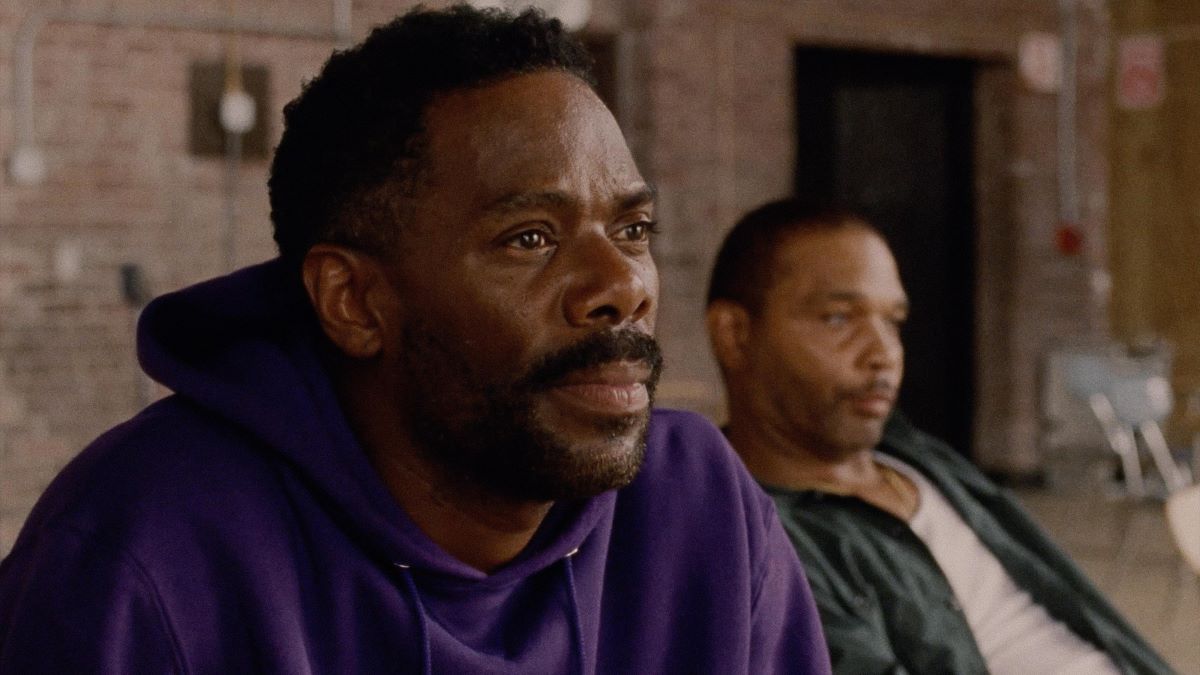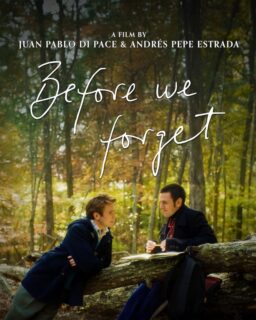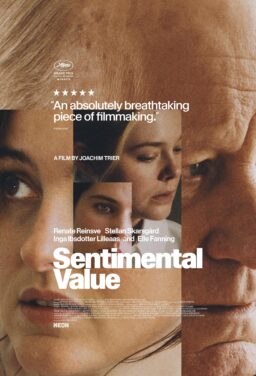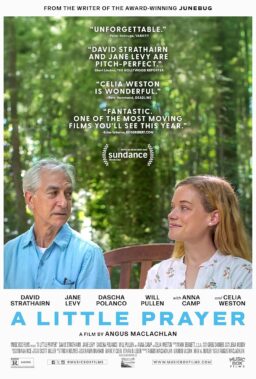“Sing Sing” is perfectly timed. As I file this, social media users are normalizing ignorance and incuriosity for clout and characterizing anyone who is interested in art that they don’t already know they like as “pretentious,” or claiming they are faking their enjoyment of it. It’s as if they’re trying to shame others for wanting to expand their minds. The opposite mentality is represented in this film based on a true story, about people who are incarcerated in a maximum-security prison who treat the arts the way shipwreck survivors treat life preservers. The characters are men who feel direct sunlight only in daily walks in the yard, and regularly have to submit to strip-searches and hit the floor face-down whenever an alarm sounds. They recite Shakespeare, poetry, and their own material, and briefly feel liberated. It’s an engrossing and often funny work with a big heart and superb actors, many of whom studied theater behind bars.
Director Greg Kwedar and his co-writer Clint Bentley adapted the script from John H. Richardson’s 2005 Esquire article “The Sing-Sing Follies” and added embellishments, many devised by the cast, drawing on their own experiences. It was shot at Sing Sing and in a variety of other locations standing in for Sing Sing, including a decommissioned penitentiary and a high school. The same filmmaking team also co-wrote and directed another slice-of-life character-driven drama, “Jockey,” Both films seem to have been made in the spirit of abandoning one’s ego: although “Sing Sing” is filled with thoughtfully blocked group scenes and compositions that compare freedom and incarceration (I didn’t realize that Sing Sing is the only working prison in the world that freight and passenger trains run beneath!) the movie is more likely to just park the camera on the face of a man who is incarcerated as he performs a scene from a play or delivers a monologue drawn from his experience. There’s a rich tradition of filmmaking that draws equally on dramatic and documentary techniques. “Sing Sing” is a fine addition to it. Some of the group discussions are reminiscent of the moments in Hal Ashby’s classic VA hospital drama “Coming Home” where real-life Vietnam veterans talk extemporaneously about their war experiences in “rap sessions.”
Although the profanity, slang, and threats of violence are modern, and the program that introduces men who are incarcerated at Sing Sing penitentiary in Ossining, New York to theater—Rehabilitation Through the Arts, or RTA—was not implemented until 1996, it’s easy to imagine this film having been made and released in the 1960s (the tall, broad-shouldered Domingo’s silhouette evokes Burt Lancaster’s in the great prison drama “Birdman of Alcatraz”). Or perhaps earlier: the backbone of the movie is the unlikely friendship between Domingo’s character, the sensitive and empathetic Divine G, who’s behind bars for a crime he didn’t commit, and Clarence “Divine Eye” Maclin, another graduate of the real-life program who was sent to Sing Sing for armed robbery and plays a version of himself; the distinctively direct, at times “hard,” way they speak from the heart to one another channels black-and-white B-pictures where a slum kid becomes a priest who never stops trying to save the soul of his childhood friend who became a gangster. (When Maclin uses the N-word in an argument with Divine G, the latter informs him that the group has a rule against using that word and that he is henceforth required to replace it with “beloved.” And he does.)
The men in the story live in cells smaller than a lot of people’s bathrooms, but the ones who’ve decided to take advantage of the program immerse themselves in the history and traditions of theater and discuss the practical aspects of performance (such as blocking, tone, and memorization) with the intensity of athletes trading tips on how to improve their games. Few things are as innately cinematic as people in desperate circumstances doing what they can to better themselves.

“Bob Trevino Likes It” is an example of what some people have called “Nicecore,” a work of art that stresses kindness, generosity, empathy and other positive behaviors and doesn’t undercut them with irony or cynicism. The main character, Lily Trevino (Barbie Ferreira), is a 25-year-old home care nurse whose father Bob (French Stewart) is a raging narcissist, the kind of guy who sits across from his daughter at lunch as she spills her heartbreak and barely looks up from the iPhone he’s using to determine which blonde from his senior community to date next. Lily’s mother, an addict, deserted the family when Lily was very young, and even though her dad stepped up, he openly resented Lily and treated her as more of a burden than a daughter. He’s about as irredeemable as a movie dad can get without committing crimes.
Then the two have a fight and Bob impulsively decides to cut Lily out of his life, even blocking her on Facebook. When Lily, who thinks her dad simply unfriended her, tries to reconnect with him on the app, she types “Bob Trevino” into the search bar and comes up with several matches that aren’t her father and one that has no avatar. That’s the one that she sends a new friend request to. The account belongs to a different Bob Trevino, played by John Leguizamo. This Bob is the sort of man Lily always wanted for a dad. He’s kind, responsive, a great listener, wise, honest, a fan of corny jokes, and reflexively “likes” every social media post she puts up. When Lily’s client’s toilet overflows right before she’s supposed to have her first meeting with new Bob at a diner, she impulsively calls and asks him for help. Not only does he show up quickly and fix the toilet, he takes her to a hardware store to shop for necessities that her biological father never told her she needed.
You might be reading this thinking, “I wish life were like this.” I was thinking the same thing all through “Bob Trevino Likes It” because I didn’t read the press notes before the screening (I generally avoid doing that because I like to have as fresh a response as possible). Turns out the film’s writer and director, Tracie Laymon, is telling a strange but true story that happened to her but changing key details because, as she explained at a SXSW screening, she didn’t want to get sued by her biological father.
What about Bob, though? We’ve been conditioned to expect that no nice person that we meet in fiction can possibly be just nice: they invariably turn out to have some dark secret or be hypocrites or con artists or worse. That’s not the case with the other Bob. He’s exactly as advertised. It’s a career-capping performance for Leguizamo, a versatile performer who has often been cast as eccentrics, grotesques, and villains but has rarely been given the chance to rise to what some actors consider the ultimate challenge: playing a main character who’s a genuinely good person and keeping him interesting. This is Tom Hanks-caliber sunshine-and-lollipops acting.
There’s no point pretending this is a perfect work of cinematic art or that parts of it don’t seem contrived or not-fully-baked despite the fact that it’s rooted in reality. Bob’s wife Jeanie, played by Rachel Bay Jones, is an adoring lady who’s into scrapbooking, but lacks dimension beyond that, and she struck me as too immediately accepting of her husband running off to meet a 25-year-old woman that he met online. There are a few scenes that verge on cute, in a ’90s Sundance indie comedy sort of way. But any complaints I might have about “Bob Trevino Likes It” are minor in the greater scheme. Like “Paterson” and “Field of Dreams,” this is the kind of movie that will make certain viewers roll their eyes but inspire others to see it multiple times in a theater, just to have that great feeling again.

The thriller and the horror movie are adjacent modes of filmmaking. “Hood Witch” perches on the dividing line like a raven. Co-written and directed by Saïd Belktibia, it focuses on a single mother named Nour (Golshifteh Farahani of “Invasion”) who’s a witch, makes a living smuggling ritually necessary creatures into France, and is developing an app called Baraka that will connect witches, sorcerers, shamans and other practitioners of ancient rites (imagine an international Craigslist for the dark arts). The film is also a domestic drama: Nour lives with her barely adolescent son Amine (Amine Zariouhi) in a forbidding apartment complex and is constantly being harassed by the boy’s father, her controlling and abusive ex-husband Dylan (Jérémy Ferrari), who wants full custody and will stop at nothing to get it.
When Nour is blamed for a tragedy she had nothing to do with, the apartment complex turns on her and begins a 21st century witch hunt, chasing after Nour in hopes of punishing or even killing her; at the same time, Dylan and his allies in the criminal underworld (who are themselves connected to Baraka) exploit the situation to try to nab Amine.
The middle hour of “Hood Witch” is as unrelentingly intense as anything I’ve seen, with mother and son pushing the limits of their ingenuity to stay alive through the madness and reunite. The movie’s final act is anticlimactic and feels rushed, or maybe I only feel that way because I identified with the main characters and despised the people who were making their lives miserable and wanted a more suitably prolonged punishment to be dished out.
Still, at its best—which is to say, during the long midsection where Nour and Amine are being hunted—the movie melds the physical, virtual, and metaphorical ideas of the phrase “Witch Hunt,” serving up the masochistic pleasures of a melodrama about persecuted innocents, then turning into a revenge flick. They messed with the wrong witch.












